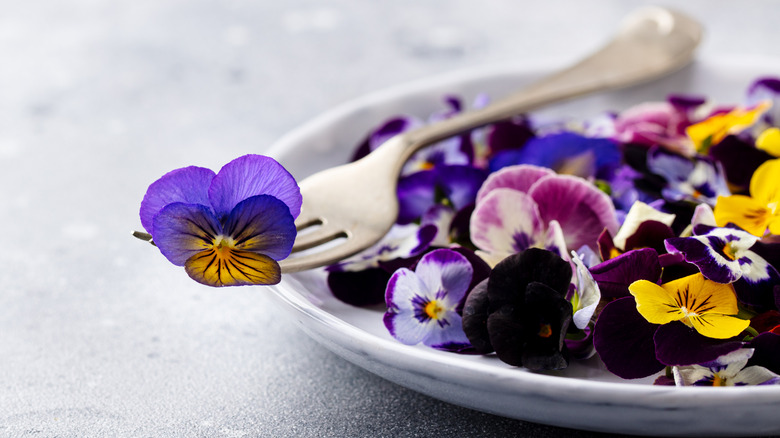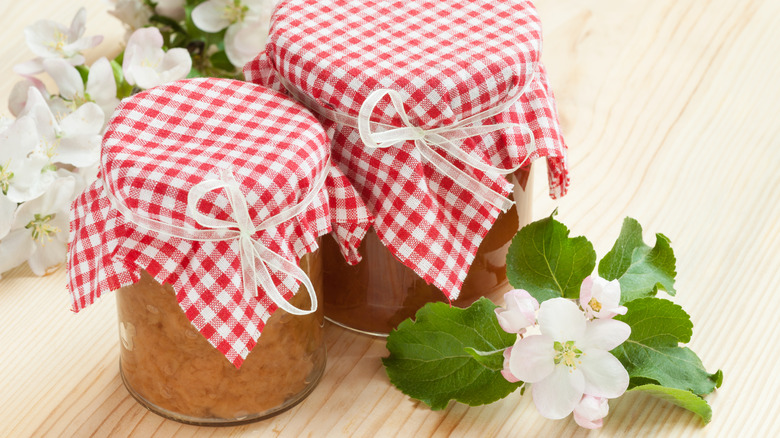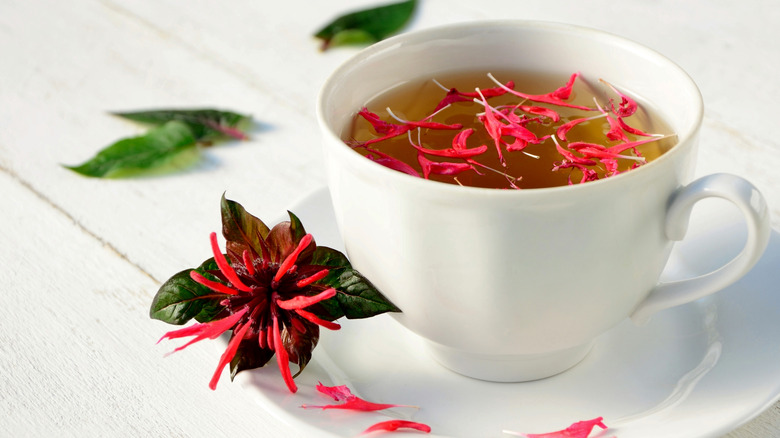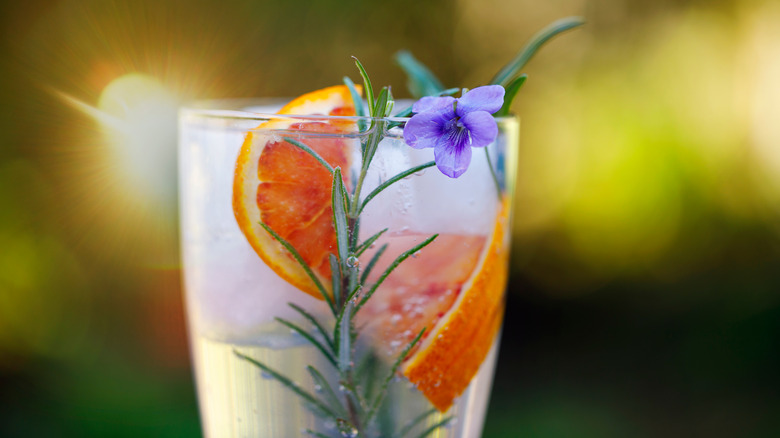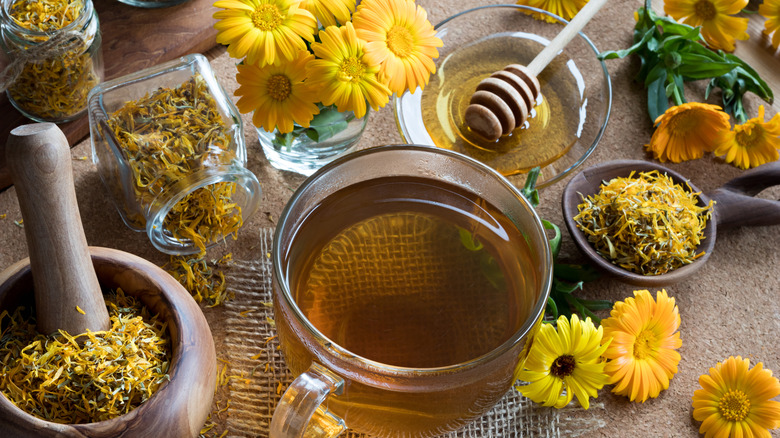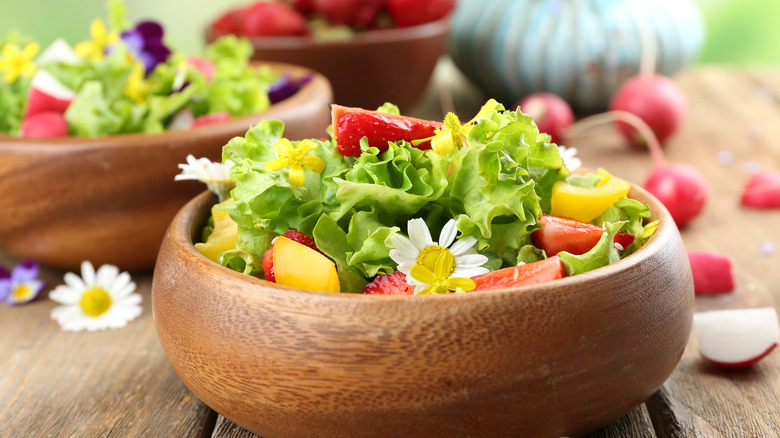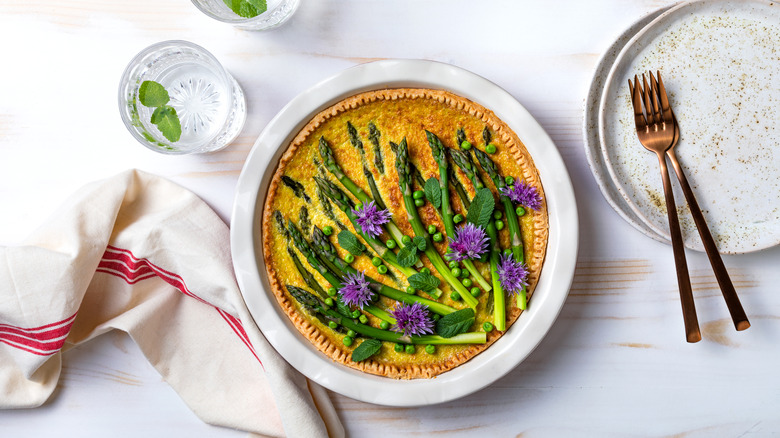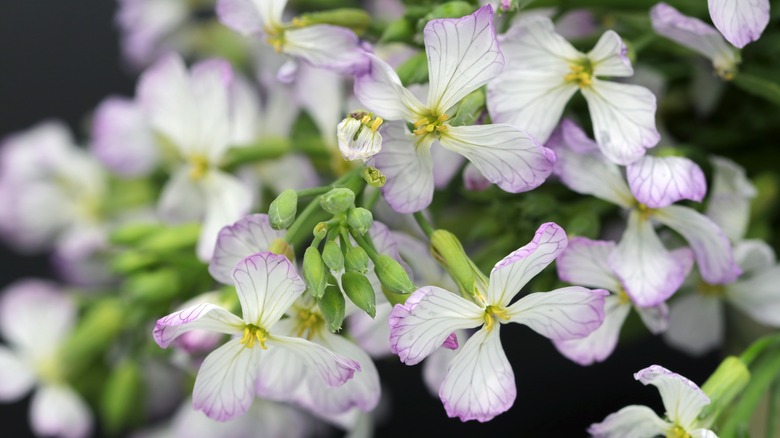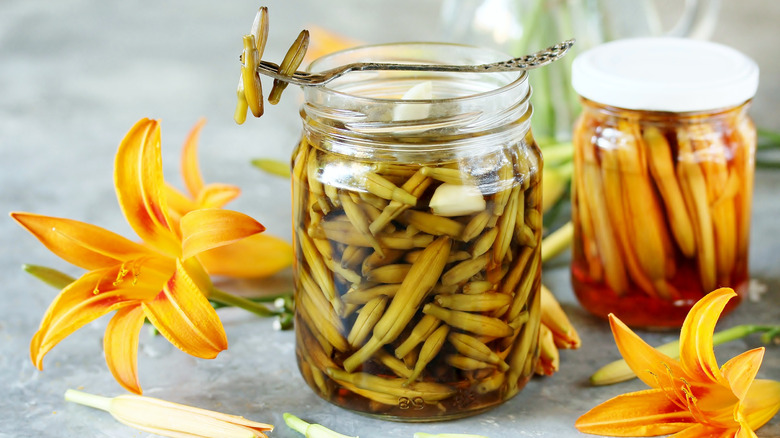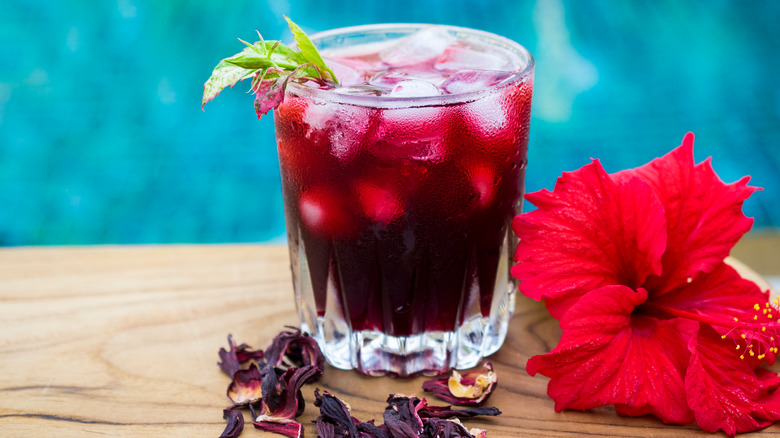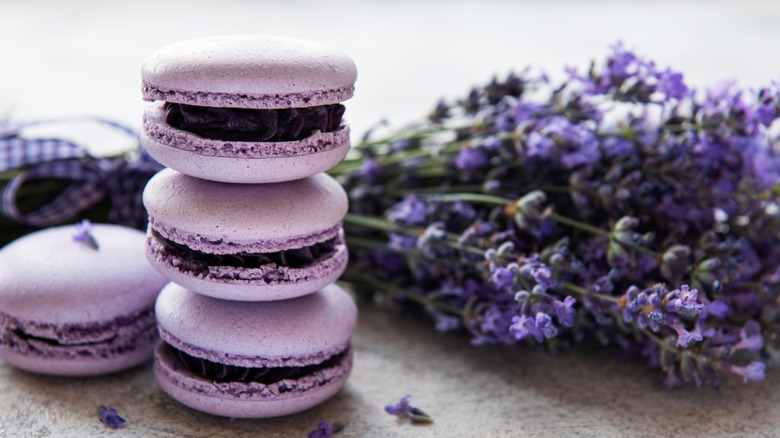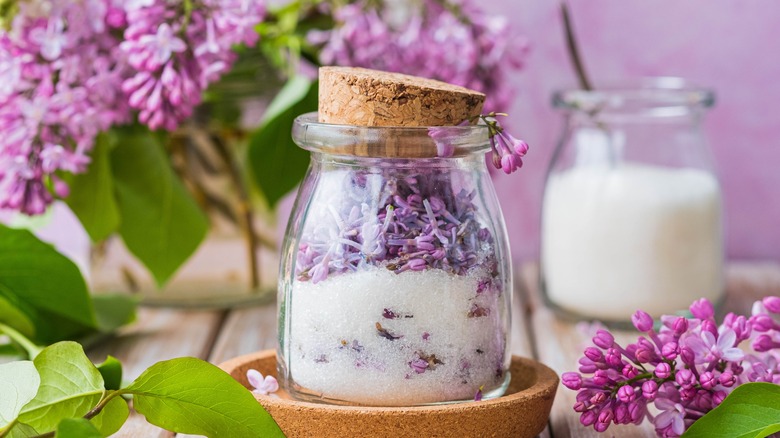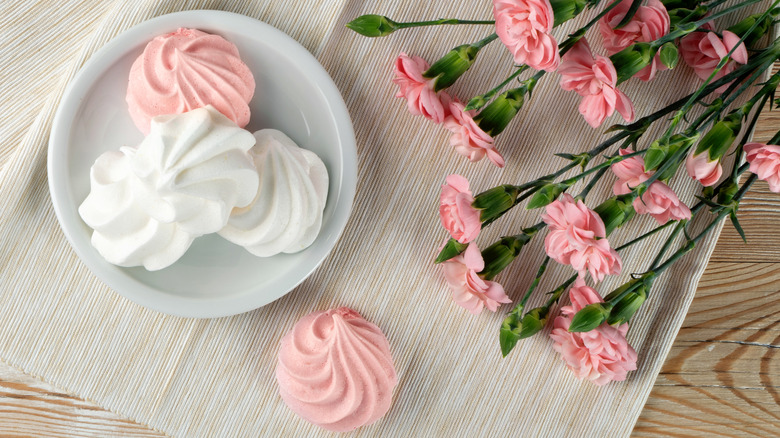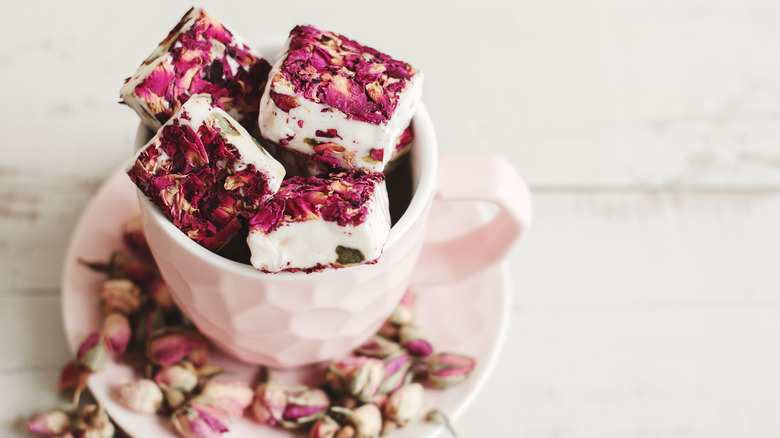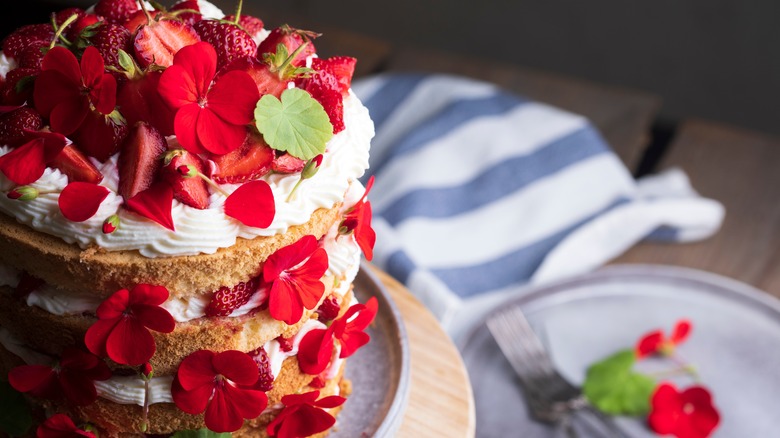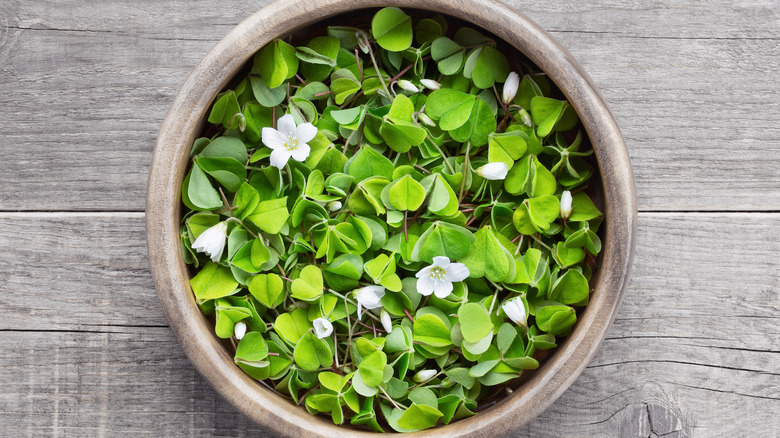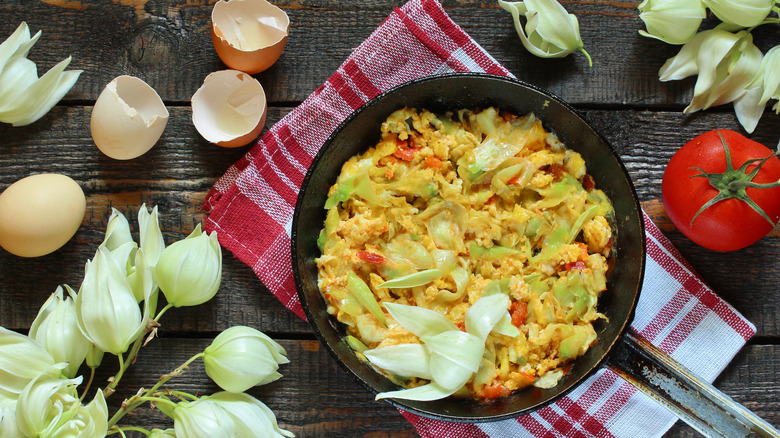18 Edible Flowers And How To Use Them
Per Dictionary.com, ambrosial is defined as exceptionally pleasing to taste or smell; especially delicious or fragrant; worthy of the gods; divine. So, if you're not yet cooking with edible ambrosial flowers in your recipes, the only question we have for you is ... why not? Flower cookery, as it's called by What's Cooking America, may have had its heyday back when Queen Victoria occupied the throne (and are we surprised?), but that's no reason to dismiss it as a thing of the past. Edible flowers add class to any dish they encounter. They also give us novice chefs a fun challenge as we experiment with colors, flavors, and quantities.
There are two important factors to stay on top of whenever you're cooking with edible flowers. First, be absolutely certain you have the correct plant because many flowers resemble each other, and while some are edible, others are actually poisonous. Check botanical classifications and make purchases from reputable outlets before heading off into the woods to forage on your own. Second, steer clear of plants that have been sprayed with harsh commercial pesticides and always wash petals before adding them to a dish. One final tip from What's Cooking America: Try not to overdo it when it comes to edible flowers. Even the most delicious of these has the potential to cause mild gastrointestinal distress when consumed in large quantities.
With all that said, it's time for some culinary exploration. Below we give you 18 flavorful, edible flowers that go well beyond pretty garnish status, with a slew of new ideas for incorporating them into drinks, side dishes, savory entrées, and desserts.
Apple blossoms
We don't have to wait for fall to enjoy the culinary abundance of apple trees because they grace us with a flush of edible blooms earlier in the year. Perhaps the best thing about apple blossoms is they can be found in abundance on those otherwise-seemingly-useless crab apple trees in our backyards. Though, to be fair, in an excerpt from The Fruit Forager's Companion (via Chelsea Green Publishing), author Sara Bir explains that there's actually a lot a patient forager can do with crab apples, provided you're willing to take your time picking and taste as you go.
If risking a super sour bite into an unknown variety is not your cup of tea, stick to using just the flowers, which are guaranteed to offer a subtle yet sweet apple flavor that you can use to create a delicate apple blossom jelly. Keep an eye on the calendar because, as explained by Bishop's Orchards, different varieties of apple trees erupt into bloom at different times of the season.
Bee balm
Bee balm (Monarda didyma) is part of the mint family and is often referred to as bergamot. Its richly textured profile layers hints of mint, oregano, and orange for a taste reminiscent of Earl Grey tea. Per Plant Addicts, it was Oswego Indigenous Americans who first thought to use bee balm leaves and flowers for tea. The concoction yields medicinal benefits, including improved digestion as well as relief of nausea and sore throats. A bee balm plant would be an easy-to-grow addition to a garden considering it is winter hardy in almost every region. The fragrant, stringy crimson flowers bloom from summer to fall.
There's also a pale purple variety called Monarda fistulosa that grows as a wildflower clear across North America. It's relatively easy to find and popular amongst foragers for its similarity to oregano. For a zesty, almost savory biscuit option, you can add it to baked goods, like cookies.
Borage
Borage is also blueish-purple, but let's be honest, these petite cucumber-flavored flowers are much cuter than the straggly bee balms. (No offense, Monarda). Borage is a versatile flora that can run the gamut from salad topper to savory soups to desserts, cheeses, and yogurts. Mixologists from Borrago love to use it to enhance refreshing beverages like a non-alcoholic borage fizz with lemon or a strictly-for-adults garden gimlet.
These types of drinks would benefit from a borage simple syrup, which can be made by first boiling equal amounts of sugar and water until the sugar dissolves. Remove your saucepan from the heat and stir in borage flowers to infuse the syrup as it cools. Borrago further recommends creating gorgeous borage flower ice cubes that really up the wow factor when serving these decadent cocktails to your guests. We think this could be done with just about any of the colorful edible petals listed here. With so many uses, your kitchen will flourish under a barrage of borage.
Calendula
Calendula is well known for its anti-bacterial, -oxidant, -inflammatory, and -viral properties (via The Kitchen Apothecary). It's a popular addition to soothing balms, lotions, and fizzy bath bombs. Internally, calendula has an ancient history of being consumed as a medicinal herbal tea.
From a culinary perspective, calendula flowers can bring a peppery note to tarts and sauces. The pigment in their petals will dye whatever it's combined with reddish-orange, so use them to enhance the vibrancy of egg yolks and cheeses. In addition to scrambled eggs and frittatas, the Chestnut School of Herbal Medicine suggests mixing calendula blossoms into salsas, soups, and saag paneer. Dried flowers can be stored for use in the winter months to boost the body's immunity through tonics and bone broths with seaweed and mushrooms. One word of caution here: As an herbal folk medicine, calendula is used to encourage menstrual cycles. Therefore, this flower should be avoided by people who are pregnant or trying to become so.
Chamomile
According to La Cucina Italiana, chamomile is the little flower that could — it has a near-unlimited list of uses. Of course, we all recognize chamomile as a relaxing herbal tea perfect at the end of a stressful day, but the yellow and white flowers of the Chamaemelum plant can do so much more.
You have two primary options when using these flowers in a recipe; sweet German chamomile (Matricaria recutita) or the slightly more bitter Roman chamomile (Anthemis nobilis). Depending on your palate, either will work in jam, sweet cream, pastries, and so much more. Mix 2 tablespoons of fresh flowers with an equal amount of olive oil, a tablespoon of honey, and a splash of lime juice for a simple salad dressing. Season with salt and pepper. And, if our chamomile stone fruit salad recipe is any indication, these edible flowers also ego great with the tastes of the season.
Chives
Regular and Chinese chive blossoms can be added to dishes that call for a hint of onion or garlic. In particular, blossoms from Chinese chives will add a kick as a garlic substitute even more than the plant's leaves can. The buds open up into a small purple pompom. They can be eaten as is, cooked into a recipe, or used for garnish. As noted by Garden Betty, chive blossoms even taste good pickled or deep fried. They also go a long way to flavor up an herb-infused vinegar.
Use them on their own for chive blossom vinegar or include them in a larger mix of herbs. It'll only take a few minutes to set up; then, you'll let it steep for about four days. The purple from the flowers will transfer to the vinegar, giving it a blushy lavender tint. Home cooks can use chive blossom-infused vinegar to brighten up a simple vinaigrette salad dressing that you'll want to mix and shake just before serving. The remaining vinegar will be a shelf-stable item you can store in a cool, dry place and use for other meals later.
If you're not growing them in a garden, you may find chive blossoms at a farmer's market or your local specialty produce store.
Daikon
From Konnichi Wa, we learn that daikon translates from Japanese to English as large root. Unlike the typical small and spicy red radishes that appear in summer gardens throughout the States, the daikon variety grows up to 3 feet long. It is considered a cool weather crop and is generally harvested later in the year and through winter. Daikons are milder in flavor and have all-white flesh and skin. Any plants left to bolt will produce delicate white flowers with purple rims that taste very similar to the daikon itself, just a milder still.
Available in spring and summer, Specialty Produce suggests using the blossoms alongside the root as a complementary flavoring, making them a great addition to any Asian-inspired cuisine. Or try blending them into a cream cheese spread the same way you would chive, cilantro, or dill. Daikon blossoms will also mix effortlessly into crab dishes with lemon.
Daylily
The name daylily is a bit of a misnomer because these robust and brightly colored blooms are not true lilies. This is a good thing when it comes to dining because true lilies are poisonous and should not be ingested. Daylilies (Hemerocallis), on the other hand, are so delicious that James Beard Award-winning chef Hank Shaw goes on about them at length on his Honest Food blog. On their own, unopened flower buds need little more than a few minutes sautéeing in oil with a dash of salt to create a delectable side dish. You'll also find them pickled or as an ingredient in Chinese hot and sour soup.
Daylilies have naturalized themselves in most states across the country, which makes them incredibly easy to find throughout late spring and all of Summer. June is the peak season for these over-abundant bloomers that many now consider a weed, though an absolutely gorgeous one at that.
Hibiscus
Does anything scream tropical bliss more than the hibiscus flower? If ever there was a single bloom that could whisk us away to a warm sunny day lounging on the beach of an equatorial island, this is it. Use only the petals to make hibiscus iced tea, the go-to recipe for this bright red flower that produces a deep crimson infusion. According to the Cleveland Clinic, hibiscus tea is not only refreshing on a hot day; it is also rich in antioxidants and known for lowering blood pressure and cholesterol.
Hibiscus cocktails are popular among connoisseurs. For the slightly less adventurous among us, the tart cranberry flavor of the flower petals also combines well with strawberries for a delectable hibiscus jam (that may or may not also taste really good when mixed into those cocktails).
An important note on hibiscus is that not all varieties are edible. Morning Chores lists Jamaican sorrel (Hibiscus sabdariffa) and cranberry (Hibiscus acetosella) as the most common edible options; both have tart cranberry flavors with a touch of lemon. A third, called edible leaf hibiscus, physically resembles hibiscus flowers but actually belongs to a different genus (Abelmoschus manihot). You may see it listed as sunset hibiscus or hibiscus manihot.
Lavender
Lavender is such a pretty flower with a lovely perfumed scent that many of us wouldn't think of it as an herb. Yet it's actually a member of the mint family and a close cousin to common kitchen spices like thyme, sage, and rosemary. According to What's Cooking America, English lavender (Lavandula angustifolia) rose in popularity during the 17th century and has since become the most commonly used culinary variety. Lavender has a strong floral scent, which is intensified when the flowers are dried, so it needs to be used in moderation.
Chefs like to get very creative with lavender and refuse to limit its uses to pretty desserts. This herb can be incorporated into just about every kind of recipe out there. From a surprising floral ingredient to add within your next latte to this refreshingly aromatic plum and lavender pie recipe — there are so many ways to utilize this edible flower. When you're ready to add it to entrées, the citrus notes of lavender pair well with oregano and thyme.
Lilac
Lilacs arrive in the springtime to refresh our senses and awaken us from our wintery slumber. Their scent and flavor are truly floral, and the color of these flowers is so beautiful it has its own shade of purple named for it.
The Outdoor Apothecary gives us seven delectable ways to incorporate lovely lilac flowers into our diets. Wine enthusiasts can experiment with lilac wine, while the bakers among us can concoct simple syrup infusions, jellies, and desserts like lilac and lemon shortbread cookies. Pictured above, and for those of us hoping to bottle the essence of early spring, lilac sugar is an easy-to-make staple that requires only two ingredients and a jar. Harvest blossoms when they're in full bloom, and keep them dry, so they don't dissolve the sugar. Then pluck the tiny individual flowers from the larger cluster and drop a tablespoon of them between layers of sugar in the jar; shake, store, and you're done.
Nasturtium
Nasturtium-infused vinegar is a popular way to use this radiant trumpet-shaped flower that comes in shades of red, orange, and yellow. Ask the Food Geek says all colors taste the same and describe its flavor as mild and a bit spicy, similar to arugula. The self-proclaimed food geek adds that nasturtiums' food dye capabilities are the main attraction, so have some fun infusing vinegar and clear alcohols with this one. You could also hang a bouquet of nasturtiums to dry, then crush the dried flowers and mix them into a savory, now-brightly-tinted seasoning salt.
As a garnish, nasturtium blossoms will vibrantly brighten up salads, cheese plates, and pasta dishes as well. Nasturtium leaves are just as tasty as the flowers. Including them alongside the blossoms will add an earthy layer to any dish. These flowers offer quite a few health benefits as well. They have a high vitamin content level and may help prevent everything from dermatitis to hair loss to cardiovascular disease.
Pea blossoms
An internet search for edible pea flowers may cause some confusion. So, before we dive into cooking with them, let's make sure you've got the right plant in hand. Ornamental sweet pea flowers (Lathyrus odoratus) found in the wild are absolutely poisonous and, therefore, should never be consumed in any capacity. Then, there are butterfly pea flowers (Clitoria ternatea), which are safe to eat and will allow you to create magnificently blue-hued beverages. Try them in lemonade or use them in powdered form as a cerulean substitute in your next matcha latte.
Finally, true edible culinary pea blossoms (pictured above) come from the same plant as actual garden peas. These are botanically classified as Pisum sativum. The flowers tend to be crunchy and ... guess what? They taste a lot like peas! You may see them listed as pea tendrils or pea shoots in recipes. These are catch-all terms referring to the vines, stems, and flower blossoms altogether. Unlike their wild cousin, all parts of your standard garden pea plants can be consumed safely and deliciously.
Pinks
Edible clove pinks, which are also called Dianthus, look a lot like carnations. They're from the same botanical family, but they stand apart when it comes to their culinary prowess. The flowers are equally beautiful, but the fragrance of a clove pink has a touch of spiciness to it.
Per Gardening Know How, these peppy, bubblegum-colored flowers are easy to find blooming from mid-spring into mid-fall. If you add them to your garden, give them a spot with full sun exposure for part of the day. And if pink is just not your thing, check out some other varieties like Cheddar (Dianthus gratianopolitanus) or Cottage (Dianthus plumarius) for an array of color options.
While this ingredient can make any food beautiful, before tossing pink petals on top of a salad like Wolfgang Puck, you should cut off any white heels to avoid bitterness. One more reason to bring clove pinks into the kitchen is for their medicinal benefits. They've been shown to lower tension and relieve heartburn and gas.
Roses
Even when used simply as culinary decorations, roses elevate the elegance of whatever's cooking. With thousands of cultivated hybrids — all of them edible — you're sure to find pleasure in picking your favorite. Each variety will add a slightly different aroma and sweetness to your culinary creations and color. As is to be expected, the stronger the scent, the more flavor punch it will come with it.
Ode Á La Rose suggests cutting flowers in the morning while it's still relatively cool, but remember that fresh petals should not sit out for more than two hours before being added to recipes. If you don't plan to start cooking until later, it may behoove you to hold off on your trip to the garden.
Rose-based recipes abound. Most blossoms have a fruity and floral flavor, sometimes reminiscent of strawberries. They're often used for teas, simple syrups and sugars, and rose butter on pastries. Dried roses can also be crushed and added to savory spice mixes.
Scented geraniums
Scented geraniums can be fun to experiment with because each variety will have a distinct flavor. Choose from peppermint, lemon, rose, and more to find just the right addition to baked goods. Some recommendations, like our scallop, pine, and grapefruit geranium recipe, offer complex options with which to layer your edible flowers. Then keep some flowers intact to use as edible decorations on the final product. You can also opt to drink your geraniums in the form of geranium gin. Hammer & Son came up with a semi-floral spirit that mixes citrus and rose flavors while maintaining the dryness expected in a traditional London Dry style gin.
According to Fine Gardening, the leaves of scented geranium plants offer a stronger smell and flavor profile, so be sure to use them as well. In fact, they grow a lot faster than the actual flowers, so you may start adding them to mixed green salads before the blooms even arrive. When finely chopped, buds and leaves can be sprinkled on anything from soups and pasta dishes to fish coming straight from the patio grill.
Wood sorrel
Wood sorrel looks a lot like an Irish shamrock (clover), but it's actually a different plant altogether. The two most common types of wood sorrel have small white or yellow blossoms. They grow wild and can also be found in some garden centers where they will be labeled as Oxalis (their botanical genus name). Oxalis translates to sour due to a sharp burst of flavor that comes from the leaves and flowers. The lemony zest of freshly foraged wood sorrel makes it a tangy base for a sheep's milk yogurt or a complement to juniper berries when cooking Swedish cuisine.
Alternatively, Mother Earth News suggests a wood sorrel butter sauce for use on vegetables and seafood. Go ahead and add the flowers in with the leaves for any of these recipes. If you're foraging in the wild for wood sorrel, be sure not to confuse it with clovers. True shamrocks shouldn't make you sick, but they won't yield the same citrusy flavor profile as Oxalis.
Yucca
Almost every part of a yucca plant can be eaten, and Indigenous Americans have been doing so for centuries. Since a mature plant may only flower every other year or less, per Gardening Know How the flowers should be enjoyed whenever they're available. Your best bet in finding them is to head southwest during the spring of a particularly rainy year. Yucca blooms often last for more than a month, and fresh crunchy flower petals have a taste that resembles artichokes and green beans. Be on the lookout for old flowers, though, as they will start to taste bitter with age.
Yucca flowers are known to work well in combination with eggs and tomatoes (think frittatas and omelets). But as we head back over to James Beard Award-winning chef Hank Shaw's blog, you'll notice he suggests something very different. Shaw calls for deep frying them in a mesquite flour tempura batter. Get ready for some crispy, fried deliciousness that can be enjoyed on its own or served with your choice of hot sauce for an added kick.
